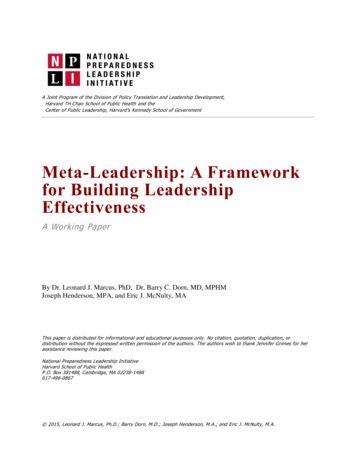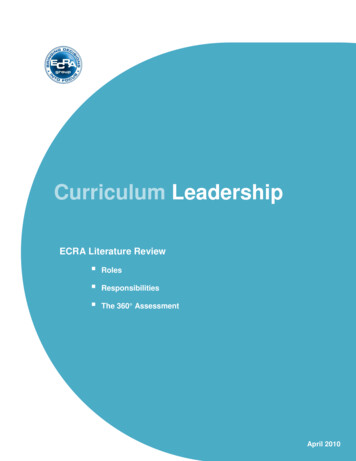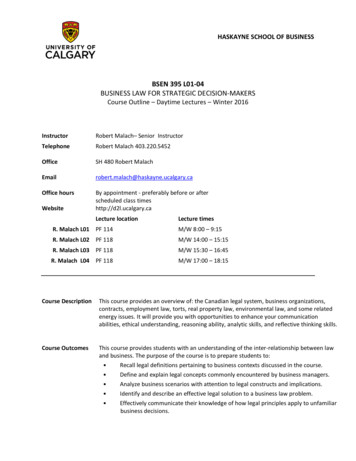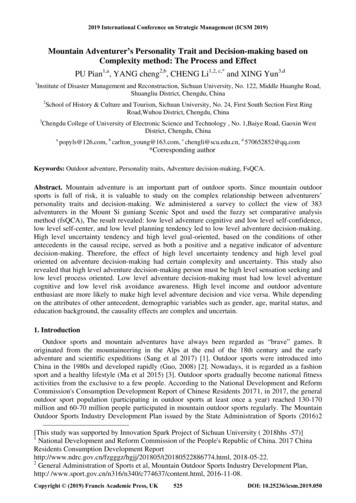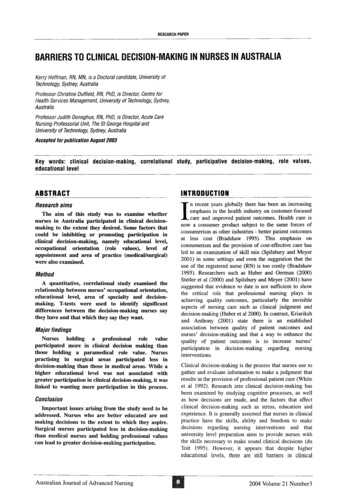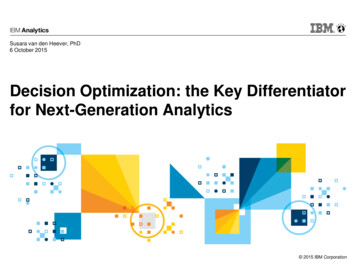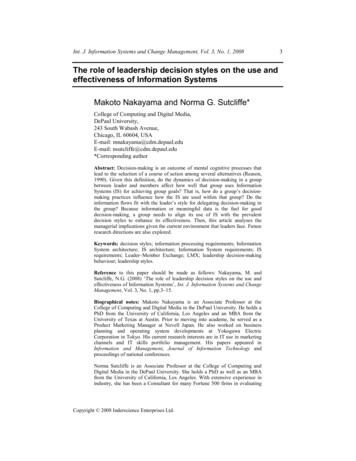
Transcription
Int. J. Information Systems and Change Management, Vol. 3, No. 1, 2008The role of leadership decision styles on the use andeffectiveness of Information SystemsMakoto Nakayama and Norma G. Sutcliffe*College of Computing and Digital Media,DePaul University,243 South Wabash Avenue,Chicago, IL 60604, USAE-mail: mnakayama@cdm.depaul.eduE-mail: nsutcliffe@cdm.depaul.edu*Corresponding authorAbstract: Decision-making is an outcome of mental cognitive processes thatlead to the selection of a course of action among several alternatives (Reason,1990). Given this definition, do the dynamics of decision-making in a groupbetween leader and members affect how well that group uses InformationSystems (IS) for achieving group goals? That is, how do a group’s decisionmaking practices influence how the IS are used within that group? Do theinformation flows fit with the leader’s style for delegating decision-making inthe group? Because information or meaningful data is the fuel for gooddecision-making, a group needs to align its use of IS with the prevalentdecision styles to enhance its effectiveness. Then, this article analyses themanagerial implications given the current environment that leaders face. Futureresearch directions are also explored.Keywords: decision styles; information processing requirements; InformationSystem architecture; IS architecture; Information System requirements; ISrequirements; Leader–Member Exchange; LMX; leadership decision-makingbehaviour; leadership styles.Reference to this paper should be made as follows: Nakayama, M. andSutcliffe, N.G. (2008) ‘The role of leadership decision styles on the use andeffectiveness of Information Systems’, Int. J. Information Systems and ChangeManagement, Vol. 3, No. 1, pp.3–15.Biographical notes: Makoto Nakayama is an Associate Professor at theCollege of Computing and Digital Media in the DePaul University. He holds aPhD from the University of California, Los Angeles and an MBA from theUniversity of Texas at Austin. Prior to moving into academe, he served as aProduct Marketing Manager at Novell Japan. He also worked on businessplanning and operating system developments at Yokogawa ElectricCorporation in Tokyo. His current research interests are in IT use in marketingchannels and IT skills portfolio management. His papers appeared inInformation and Management, Journal of Information Technology andproceedings of national conferences.Norma Sutcliffe is an Associate Professor at the College of Computing andDigital Media in the DePaul University. She holds a PhD as well as an MBAfrom the University of California, Los Angeles. With extensive experience inindustry, she has been a Consultant for many Fortune 500 firms in evaluatingCopyright 2008 Inderscience Enterprises Ltd.3
4M. Nakayama and N.G. SutcliffeIT needs, IT implementations and IT strategies. She has worked as a SystemsDeveloper on mainframe and client/server systems as well. Her currentresearch interests are in IT enabled organisational change, IT leadershipbehaviour and IT skills portfolio management. Her papers appeared inInformation and Management, Journal of Information Systems Education andproceedings of national conferences.1IntroductionIs there a recognised typology for decision-making within a group? After all, decisionmaking is a key managerial responsibility that is performed in a number of ways. Theorganisational leadership literature covers several leadership styles or patterns ofleadership behaviour, which all fall on a continuum with authoritarian and democraticend points. Decision-making leadership style is one of these that lie on this continuum;other leadership styles on this continuum are the relationship vs. task orientation endpoints, the consideration of welfare vs. the initiation of structure end points and themotivation to manage vs. the urge to delegate end points (Bass, 1990).Yet, regardless of who makes the decisions in a group, relevant information (i.e. factsimbued with meaning) is needed for a quality decision. A number of early studies(Mintzberg, 1973; Carroll and Gillen, 1987) reported on how information is gathered inspurts, with little analysis and a heavy reliance on judgment and intuition for decisionmaking. However, this was before technology-based Information Systems (IS) becamesuch an integral part of the environment with both leaders and members depending onthese systems. IS collect, process, store and generate meaningful facts to help individualsmake consequential organisational decisions (Gupta, 2000). So, with this reliance on IShave the dynamics of decision-making in a group influenced how well that group uses ISfor achieving its goals?In the following sections, we focus on leadership studies from two streams; theleadership styles for decision-making and the Leader–Member Exchange (LMX). Then,we scrutinise the impact of IS on leadership behaviours. Our attention then turns toleadership styles, stability of leadership styles, decision-making of leaders and IS,followed by propositions. Finally, we discuss implications and future research directions.2Leadership studies2.1 Leadership styles for decision-makingGroups within organisations must constantly make decisions based on the informationthey have. Within a group, the leader, the members or both can make the decisionsaffecting the group’s activities. Tannenbaum and Schmidt (1958) proposed that acontinuum exists with the leader deciding (directive or autocratic) to the membersdeciding (laissez faire or delegation) as end points.Between these two end points, numerous researchers (Tannenbaum and Schmidt,1958; Bass and Valenzi, 1974; Vroom and Yetton, 1974; Flamholtz, 1986, 1990; Herseyand Blanchard, 1996; Sutcliffe, 1999; Yuki, 2006) delineate and define consultative and
The role of leadership decision styles on the use and effectiveness of IS5participative leadership styles where the decision-making is interactive and sharedbetween the leader and members of the group. Generally, the consultative style has theleader describing a situation to members and asking for their opinions before the leadermakes the decision. The participative style has the leader presenting problems tothe group, getting suggestions and asking for a consensual decision. In contrast, under thelaissez faire or delegation style, the leader lets the members make the decisions. Underthe directive or autocratic style, the leader makes the decisions without anymember input. These studies use the group as the unit of analysis. A group consists ofone leader and one or more members that all having the same type of decision-makinginteractions with the leader. That is, all members in a given group have the samedecision-making authority.2.2 Leader–Member ExchangeAnother research stream, LMX, takes a different direction by looking at the one-on-oneor dyadic relationships between the leader and each member in the group (Graen andScandura, 1987; Graen and Uhl-Bien, 1995; Hooper and Martin, 2008). The theoreticalbasis of these LMX studies is“that dyadic relationships and work roles are developed or negotiated over timethrough a series of exchanges or ‘interacts’ between a leader and member.”(Bauer and Green, 1996)In particular, LMX compares and contrasts those who are in the ‘in’ faction of the groupvs. those who are in the ‘out’ faction. The members of the ‘in’ faction are those that theleader highly values; the members of the ‘out’ faction are those that he leader does notvalue. LMX looks at what conditions must exist between a leader and a member to makethat person an ‘in’ member vs. an ‘out’ member. Delegating tasks and decisions to amember is a clear indicator that the leader holds that member as part of the ‘in’ faction;that is, this relationship has high exchange quality (Graen and Scandura, 1987; Graen andUhl-Bien, 1995; Bauer and Green, 1996).In one LMX study, decision-making was studied. The concept of decision influencedefines five decision procedures along the same (Tannenbaum and Schmidt, 1958)continuum which correspond to the leadership styles already detailed. The twoantecedents to use a specific decision procedure was the performance level of themember and the quality of the LMX. Leaders gave those members with higher qualityLMX (‘in’ faction members) and higher performance levels greater decision influence(Scandura, Graen and Novak, 1986). That is, leaders let the high quality ‘in’ LMXmembers make the decisions, whereas leaders make the decisions for the low quality‘out’ faction LMX members. The ‘in’ LMX faction uses the laissez faire or delegationstyle and the ‘out’ LMX faction uses the directive or autocratic style.The biggest difference between the two research streams on decision-making ingroups is that LMX divides the group into factions and treats each separately, whereasthe traditional leadership style studies treat the group as a single entity in determining theantecedents to the selection of a decision-making style.
6M. Nakayama and N.G. Sutcliffe2.3 Information SystemsThe execution of leadership transpires through the availability and access of information.Given that, modern organisations critically depend on IS and the appropriate use ofleadership styles, the relationship of IS and its associated Information Technology (IT) toleadership behaviour has received little scrutiny.Past studies analyse the impact of IT on organisational structure and function. The useof IT increases the timeliness and quality of organisational decisions, the autonomy ofmanagers and their span of control (e.g. Huber, 1990; Ferioli and Migliarese, 1996;El Louadi, 1998; Lau et al., 2001; Sor, 2004). As a lateral or horizontal coordinationmechanism for managerial communications, the increased use of IT decentralisesmanagerial decision-making (Ferioli and Migliarese, 1996; Hitt and Brynjolfsson, 1997;Malone, 1997), decreases the size of firms (Brynjolfsson et al., 1994), and reduced levelsof hierarchy (Ferioli and Migliarese, 1996). There is also a fit between computingarchitectures and organisational forms (Fiedler, Grover and Teng, 1996). From ahistorical perspective, down-sized, disaggregated forms of organisations in the late-20thcentury have replaced the large, stable centralised organisations prevalent in the mid-20thcentury (Winter and Taylor, 1996).Receiving little attention is whether the decision-making leadership styles interactwith certain types of IS to influence the effectiveness of that IS. A fundamentaltheoretical underpinning of the above studies is their common perspective; they vieworganisations and the groups within it as an information processing entity. They look onorganisational structures as mechanisms which process information so that theseorganisations can respond to their environment (Galbraith, 1973, 1977).Under such a perspective, we view leaders as the controllers of information formaking decisions. Data are defined as facts. Davis (1999, p.108) defines information as“data that has been processed into a form that is meaningful to the recipient.” Thedistinction between data and information is critical for IS, because information reducesuncertainty for decision-making. This is especially relevant when evaluating the impactof IS on a leader’s behaviour. The key functions of IS are to collect, store, disseminateand present information; the utility of IS for leaders is through what and how IS providesrelevant information to leaders. Accordingly, to assess the IS impact, we regard leaders asagents who consume and manipulate information to make decisions.Past studies provide some insights into how leaders process information. Dearbornand Simon (1958) report that managers’ information processing is influenced bydepartmental (e.g. marketing, finance and accounting) biases. Walsh (1988), in contrast,notes that managers do not necessarily process information just for their departmentalconcerns. The study by Thomas and McDaniel (1990) shows how the informationprocessing structure (that is, the levels of interaction and formalisation) of topmanagement teams influences the way Chief Executive Officers (CEOs) process strategicinformation.In the following sections, we take a brief look at specific leadership styles and IS.Then, we follow with the leadership framework used in this study, the propositions,implications, future research directions and conclusions.
The role of leadership decision styles on the use and effectiveness of IS37Leadership and decision-makingA research consensus developed that most leaders use a variety of leadership styles,ranging from the autocratic to laissez-faire based on the situation in their interactionswith members (Bass and Valenzi, 1974; Flamholtz, 1986, 1990; Scandura, Graen andNovak, 1986; Sutcliffe, 1999). In addition, leaders tend to use a variety of styles when thedecision must have subordinates’ acceptance and/or must be high quality solutions(Heller, 1972). However, Wilcox (1982) found that the perceptions of leaders andsubordinates do not always match. Usually, leaders rate themselves more consultativethan their members rate them. So, the same actions are interpreted differently based onthe position of the person within the group.The one commonality is that all these studies look at the conditions that indicate thata given decision-making leadership style is preferable. These studies do not look at theimportance of a decision-making leadership style for the determination of future IS-basedinformation flows between leader and members.However, the Bass–Valenzi model (Bass, 1976) did look at non-computerisedinformation flows and leadership styles. Here, the leader and members form an opensystem with inputs and outputs that are moderated by the styles and the ‘within-systemrelations’. The inputs consist of attributes of the organisation such as constraints, clarity,warmth; attributes of the workgroup such as intragroup harmony, interdependence;attributes of the task such as clear objectives, routine and complexity; attributes of theattitudes such as fair, assertive and introspective. The outputs consist of work groupeffectiveness, satisfaction with supervision and job satisfaction. The moderating ‘withinsystem relations’ consist of boss power, subordinate power, information that the boss has,information that the subordinates have, the long-term objectives and the structure. Themoderating styles are on a continuum from directive to delegative (similar to laissezfaire). In this model, information is always within the model; it is with the leader or withsubordinates. It does not tell us how the decision-making leadership styles interact withthe IS, which affects the group’s effectiveness in the organisation. Thus, a key questionof this article is: given a leadership style, what are the IS requirements that facilitate useof that leadership style?3.1 Leadership decision-making categories and stylesAs already mentioned, research has identified several leadership styles on the continuumof decision-making authority (Tannenbaum and Schmidt, 1958; Likert, 1961, 1967;House, 1971, 1997; House and Mitchell, 1974; Flamholtz, 1986, 1990; Yuki, 2006).There are also corresponding decision procedures from the LMX research (Scandura,Graen and Novak, 1986). These styles/procedures are based on the degrees of freedomleaders give to their members for decision-making and can group into three categories.The categories are styles are:1directive (autocratic or benevolent autocratic style)2interactive (consultative or participative style)3non-directive (consensus or laissez-faire style, Table 1).
8M. Nakayama and N.G. SutcliffeTable 1The leadership categories, leadership styles and decision proceduresLeadershipcategoryLeadership style Definition – leaderDirectiveAutocraticDeclares what is to be done ‘Autocratic’without explanationBenevolentautocraticDeclares what is to be done – None specifiedwith an explanationConsultativeGets opinions beforedeciding on the planpresentedInteractiveParticipativeNon-directive ConsensusLaissez-faireSource:LMX decision procedures‘Minimal DecisionInvolvement’ frommembersFormulates alternativeswith members, then leaderdecides‘Consultation’ more frommembers ‘Collaboration’even more from membersin formulating alternativesGives all in the group haveequal voice in makingdecisions– None specifiedLeaves it to the member(s)to decide what to do‘Delegation’Scandura, Graen and Novak (1986) and Sutcliffe (1999).Among leaders, there are significant differences in the delegation of decision-making. Inthe directive leadership category, managers give marching orders with or withoutexplanation. Only the leader defines problems and their priorities. In addition, the leadergives orders regarding when, what and how tasks are accomplished, and monitors closelythat these orders are followed. In LMX research, only the autocratic is discussed with nomention of the benevolent autocratic where orders are given with an explanation.Next on the delegation continuum, the interactive (consultative or participative)category has leaders seeking inputs and formulating alternatives with their membersbefore making the final decision. The communication is two-way and frequent betweenthe leaders and their members on defining problems, monitoring progress and devisingsolutions. Such communication is on-going.As mentioned before, LMX is interested on the differences between highly valuedmembers (high LMX) and other members (low LMX). LMX posits that leadercommunication and collaboration is much stronger with high LMX members from the‘in’ faction than with low LMX members who make up the ‘out’ faction. So, under LMX,the leader uses the consultation and collaboration decision procedures with the ‘in’faction and the minimal decision involvement decision procedure with the ‘out’ faction.In contrast to the previous styles, leaders using the non-directive (consensus orlaissez-faire) category style do not give direct orders. Instead, they delegate the decisionmaking to their subordinates. It is the members who define problems and determinesolutions while always informing the leader of the steps taken. However, the leader canintervene when necessary. Under LMX, the delegation decision procedure is only usedwith high LMX ‘in’ faction members.Effective managers use the directive category more often when the environment isunsettled and turbulent requiring quick decisions, whereas they use the non-directive
The role of leadership decision styles on the use and effectiveness of IS9category more often when the environment is stable (Bourgeois, McAllister and Mitchell,1978). In other words, there is a life cycle of dominant categories as environmentalstability goes through cycles such as:1organisational startup, growth, maturity and decline2market growth and decline (Muczyk and Reimann, 1987).3.2 Use of multiple leadership styles?A leader is more comfortable using one category during a major task assignment, abusiness/organisational phase or even the leader’s tenure in a job position (Fiedler, 1971).This comfort dictates the assumptions that a leader makes on the information needed tomanage the group. This is not quite the same as the leadership styles used whenmanaging and interacting with subordinates/members. Some claim that effective leadersjust focus on member needs in a situation and effective leaders change the style to meetthat situation. Such a view is found in the contingency theory (Fiedler, 1967) and thesituation leadership theory of leadership effectiveness (Blanchard, 1991; Irgens, 1995;Hersey and Blanchard, 1996). These theories posit that effective leaders change theirdecision-making leadership style as appropriate.If leaders change decision-making leadership styles flexibly and frequently, it wouldbe pointless to investigate the optimal IS requirements to target as a good match for eachleadership style. IS cannot easily change their characteristics. They are relatively stableover time. But, what about the stability of the deter
effectiveness of Information Systems’, Int. J. Information Systems and Change Management, Vol. 3, No. 1, pp.3–15. Biographical notes: Makoto Nakayama is an Associate Professor at the College of Computing and Digital Media in the DePaul University. He holds a PhD from the


